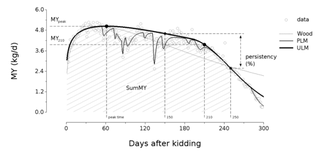
REED Kristan
- Animal Science, Cornell University, Ithaca, United States of America
- Agricultural sustainability, Animal nutrition modelling, Emissions , Farming systems
- recommender
Recommendations: 0
Review: 1
Review: 1

Diversity of performance patterns in dairy goats: multi-scale analysis of the lactation curves of milk yield, body condition score and body weight
Understanding milk and body reserves trajectories and nutrient partitioning in dairy goats through a modelling approach
Recommended by Alberto Atzori based on reviews by Kristan Reed and 2 anonymous reviewersThe dairy sector is facing an historical period of high milk demand. However, increasing feed prices continually reduces the economic margins for farms. Managerial strategies to increase economical and technical awareness of animal performance, support the decision chain and optimize the use of production inputs are increasingly necessary, especially in goat farms with intensive production systems. Among the scientific goals, there is a particular emphasis on increasing knowledge about nutrition partitioning between milk production and body reserves — a topic that not easily addressed by nutritional models, limiting the attempts at production forecasting.
The paper by Gafsi et al (2024) presents an interesting approach to studying phenotypic traits and trajectories of goat performance. It assesses the diversity of phenotypic trajectories reflecting functions such as milk production, body weight and condition score. This approaches aims to describe, understand and explore the interactions among biological functions and potential trade-offs of phenotypic trajectories across current and successive lactations. The work significantly contributes to the literature, particularly because previous descriptions of lactation curves relied primarily on mathematical outputs lacking information about the relationship among physiologically related variables.
The analysis retrieved data from about 1500 goats over more than 20 years and was conducted with a multiscale approach. Data were fitted considering different types of models, including description of perturbations for lactation curves and with multiphasic models for the body weight and body condition score. Synthetic indicators were then estimated with a multivariate approach to define fitted trajectories and changes in performance.
The association among performance directly refers to nutrient partitioning, and the adaptive response of individual animals refers to nutrient availability and their aptitude to direct the metabolic effort toward milk production. In fact, the research shows that trajectories from the first lactation were often maintained in sequent ones. Positive associations among milk curve perturbations and the individual aptitude to drive nutrients to body reserves were also observed.
The multiscale approach developed in the paper may provide original insights both for describing animal performance and for ranking individual animals within farm groups. Practically, the method could inform the development of algorithms to support culling policies and individual animal assessments. Additionally, the data are available to the scientific community for further research and applications.
I recommend this paper as a methodological example with high replicable approaches for both goats and other dairy species, with significant applicative opportunities at the farm level.
Reference
Gafsi N, Martin O, Bidan F, Grimard B, Puillet L (2024) Diversity of performance patterns in dairy goats: multi-scale analysis of the lactation curves of milk yield, body condition score and body weight. Zenodo. 10101318. ver.3 peer-reviewed and recommended by Peer Community In Animal Science. https://doi.org/10.5281/zenodo.10101318